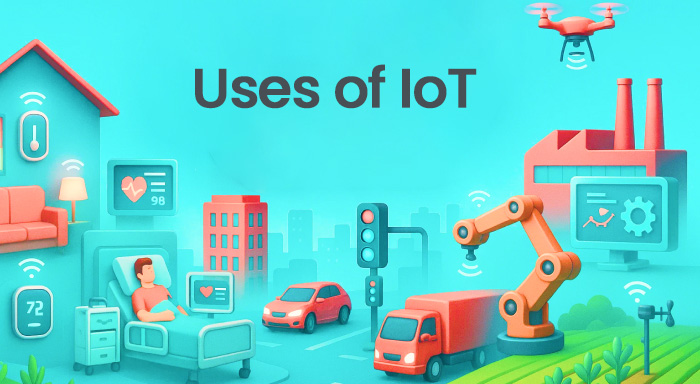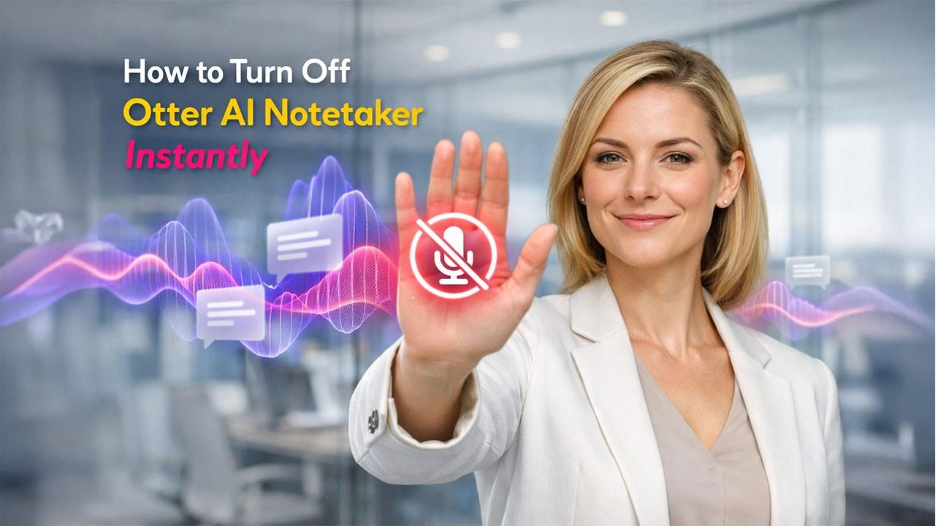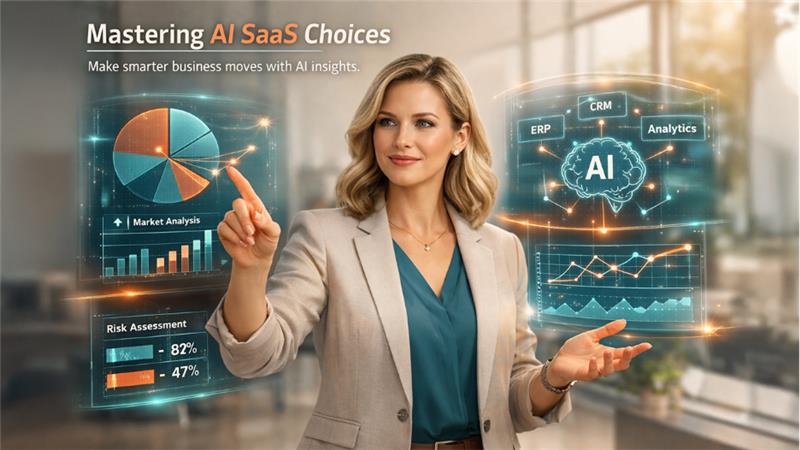The Internet of Things (IoT) is revolutionizing our lives and working patterns by connecting everyday objects to the internet. From smart homes that adjust temperature automatically to hospitals monitoring patients remotely, IoT creates a network of intelligent devices that communicate and share data seamlessly.
Today, millions of IoT devices are transforming various sectors including healthcare, agriculture, manufacturing, and urban planning. These smart technologies make our lives more convenient, efficient, and connected than ever before.
In this blog, we will explore six uses of IoT across different industries and discover how this game-changing technology is shaping our future in remarkable ways.
What is IoT?
The Internet of Things (IoT) is a game-changing technology that transforms industries and changes the way we live by expanding the Internet to incorporate actual things into our daily lives. By managing access to IoT devices, they can interact and collaborate with one another. This helps them become efficient machines and offers new insights across different areas, from smartphones to industrial machinery.
Six different applications of IoT
Smart Homes and Consumer Applications
Smart homes are one of the most well-known uses of IoT. IoT home automation combines all of your home applications- such as air conditioners, lights, locks, thermostats, etc.- into a single system that you can operate from your smartphone. Since they give you total control over how you customize your home, these Internet of Things IoT devices are becoming more and more popular.
The popularity of these IoT devices is so widespread that 127 new devices are added to the internet every second. Google Home, Amazon Echo Plus, Philips Hue Lighting System, and others are some well-known models that you may have heard of or even own in your house. The Nest Smoke Alarm and Thermostat, the Foobot Air Quality Monitor, the August Smart Lock, and many other innovations are also available for installation in your house.
Healthcare and Medical Applications
The Internet of Things is more and more digitizing the healthcare industry. Devices are being networked and then talk to one another autonomously and over distances to relay information to health workers. They include the following new IoT devices:
Wearable devices: Smartwatches or fitness trackers constantly track patients' vital signs, like heart rate or blood glucose levels. The IoT devices send the data automatically to healthcare professionals, who identify abnormalities early on and take action.
Smart hospitals: In smart hospitals, infusion pumps, monitors, and other equipment are linked to the central hospital system, which reads the data recorded in real-time. With this, doctors and nurses can respond faster to critical conditions and give their patients the best possible care.
Telemedicine: This IoT application facilitates remote monitoring and diagnosis of patients since doctors are able to remotely monitor medical equipment and make diagnoses using real-time information. Telemedicine facilitates enhanced medical care, particularly in rural areas.
In the healthcare industry, IoT technologies help towards more accurate and quicker medical care. This use of IoT enables physicians to get proper patient information for accurate diagnoses at any moment, so patients in urban and rural areas can be provided with full medical care. It promotes patient safety and decreases healthcare expenses. However, understanding IoT security vulnerabilities is crucial for protecting sensitive medical data.
Smart Cities and Urban Planning
In urban areas, IoT technologies create a more optimized framework for citizens and governments. These minimize the ecological footprint of exhaust gases, waste of resources, and any traffic jams created by high volumes of traffic.
Waste bins have sensors that track the level of fill and report automatically when they should be emptied. This cuts back on unnecessary travel and makes for optimized use of resources.
Streetlights equipped with IoT technology sense people and ambient light and can automatically adjust the lighting and save energy without harming safety.
Traffic flow is monitored in real-time with sensors and cameras. According to that information, traffic lights are dynamically set to keep traffic congestion to a minimum and lower emissions. Weather monitoring systems also play a crucial role in smart cities by providing real-time data for traffic management and emergency planning.
Parking sensors identify empty and filled parking places, prior to sending the details to incoming drivers in real-time. This minimizes the time to find a parking place and frees urban roads from traffic.
Those IoT applications enhance citizens' day-to-day lives and ease the burden on public authorities.
History of IoT: Analyzing the Origins of IoT
Industrial IoT (IIoT) and Manufacturing
In manufacturing factories, Industrial IoT (IIoT) links machines, sensors, and systems to one another. They share data in real-time and subsequently optimize their procedures accordingly. The entire field is called Industry 4.0, a prominent example of which is predictive maintenance being a prominent example of uses of IoT.
Sensors continuously track the condition of the machines and store data like temperature, vibrations, and operating hours. Firms then utilize this information to predict machine failure, which means maintenance work can be conducted precisely when it is required. This reduces unplanned downtime and maximizes the service life of the machines.
The field of IoT application Industry 4.0 encourages cost-saving and flexible production, which maximizes the availability of systems and guarantees failure-free production. The Internet of Things hence considerably raises the competitiveness of industrial enterprises.
IoT in Agriculture and Farming
We cannot survive without food, which is an essential component of life. However, it is a sad reality that while a significant amount of food is wasted in developed countries like the US, millions suffer from hunger in poor nations like Chand and Sudan.
Better agricultural methods, which can be improved with IoT applications, are one way to feed everyone. This use of IoT can be done by collecting farm data from various sources such as sensors, satellites, and local weather stations. That information is then combined with machine learning and the Internet of Things to create personalized suggestions for each farm. These suggestions help optimize fertilizer use irrigation levels, planting techniques, and more. All of this will lead to improved crop yields with an emphasis on lowering future global hunger.
Transportation and Logistics
Internet of Things use in the transport sector facilitates, among others, autonomous driving and fleet management. Driving and administrative work are automated, and as a result, the workload decreases.
Connected cars constantly gather and exchange information on their environments. Cars in the future will be able to detect obstacles, interpret traffic lights and respond to changes in traffic in real-time.
Vehicle sensors capture location, speed, and fuel usage data, with this data transmitted to an IoT hub in real-time to be analyzed. Fleet operators can utilize this data to optimize maintenance schedules and routes to reduce costs and improve utilization of the fleet.
The connectivity through uses of IoT devices increases transportation applications efficiency and safety for consumers and businesses. The administrative weight in fleet management is thus reduced, and self-driving cars can assist drivers.
Future of IoT applications
The future of IoT environments continues to develop at a fast pace, with new technologies such as 5G networks, edge computing, and artificial intelligence augmenting IoT features. We can anticipate more advanced uses of IoT applications, enhanced connectivity, and greater integration of IoT into our lives.
Emerging technologies will likely include entirely autonomous smart cities, advanced healthcare monitoring systems, and even more intelligent manufacturing processes. As IoT technology keeps becoming cheaper and more widespread, we keep seeing integration into new industries and applications that we can not imagine. Increasing demand for IoT solutions also provides many career opportunities in IoT for skilled professionals.
Conclusion
The Internet of Things already transforms many businesses and daily life- from urban areas to farming and health. The IoT examples illustrate enhanced productivity, safety, and sustainability in various industries and homes. Companies gain improved processes, more accurate monitoring, reduced operating expenses and improved business decisions in real-time. IoT devices can make homes safer and more comfortable by automating device controls. The possibilities for a more intelligent and sustainable world are endless. In order to advance in our interconnected world, we must comprehend the various uses of IoT.



